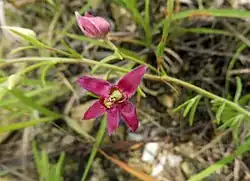Krameria lanceolata
| Krameria lanceolata | |
|---|---|

| |
| Scientific classification | |
| Kingdom: | Plantae |
| Clade: | Tracheophytes |
| Clade: | Angiosperms |
| Clade: | Eudicots |
| Clade: | Rosids |
| Order: | Zygophyllales |
| Family: | Krameriaceae |
| Genus: | Krameria |
| Species: | K. lanceolata
|
| Binomial name | |
| Krameria lanceolata Torr., 1827
| |
| Synonyms[2] | |
|
List
| |
Krameria lanceolata, commonly called trailing krameria,[3] is a flowering plant in the rhatany family (Krameriaceae). It is native to North America, where it is found in the southwestern and south-central United States, and the state states of Chihuahua and Coahuila in Mexico. It has populations disjunct eastward in the U.S. states of Florida and Georgia on the Coastal Plain.[4][5] Its natural habitat is in sandy or rocky calcareous grasslands.[6][7]
Krameria lanceolata is an herbaceous perennial that grows decumbent along the ground. It produces purple-red flowers in late spring through the summer.[6]
References
- ^ NatureServe (2024). "Krameria lanceolata". Arlington, Virginia. Retrieved 2 November 2024.
- ^ "Krameria lanceolata Torr". Plants of the World Online. Royal Botanic Gardens, Kew. Retrieved 2 November 2024.
- ^ NRCS. "Krameria lanceolata". PLANTS Database. United States Department of Agriculture (USDA). Retrieved 26 January 2018.
- ^ Alan Weakley (2015). "Flora of the Southern and Mid-Atlantic States".
- ^ Kartesz, John T. (2014). "Krameria lanceolata". County-level distribution map from the North American Plant Atlas (NAPA). Biota of North America Program (BONAP). Retrieved 27 January 2018.
- ^ a b Krameria lanceolata Flora of North America
- ^ Diggs, George; Lipscomb, Barney; O'Kennon, Robert (1999). Flora of North Central Texas. Botanical Research Institute of Texas. p. 750.
